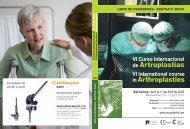cadera / hip - Active Congress.......
cadera / hip - Active Congress.......
cadera / hip - Active Congress.......
You also want an ePaper? Increase the reach of your titles
YUMPU automatically turns print PDFs into web optimized ePapers that Google loves.
VIERNES / FRIDAY<br />
282<br />
the femoral component and the posterior femoral<br />
cortex as a consequence of unremoved<br />
oseophytes or inadequate posterior capping<br />
may be responsible for painful limited motion.<br />
Plain x-rays or CT scans may detect most of<br />
the mechanically related factors.<br />
A painful stiff knee without identifi able mechanical<br />
reason has its origin in a biological<br />
process which induces inflammation and<br />
scarring of the synovium and adjacent<br />
connective tissue such as the collateral<br />
ligaments, the patellar tendon, the fat pad<br />
and ultimately the subcutaneous layer and<br />
the skin. Arthrofi brosis8 of the knee is the<br />
end stage, in the severest case it results in<br />
patella baja9.<br />
Six biological origins of a painful stiff knee<br />
have to be considered if mechanical factors<br />
have been ruled out:<br />
(1) Recurrent hemarthrosis<br />
(2) Infection<br />
(3) Herotopic ossifi cation<br />
(4) Allergy<br />
(5) Complex regional pain syndrome.<br />
Recurrent hemarthrosis is a clinical diagnosis<br />
in the early postoperative periode. Aspiration<br />
is the fi rst diagnostic and therapeutic method<br />
of choice, but if recurrency persist arthrotomy<br />
is occasionally required. Aspiration is also<br />
mandatory if pain and swelling increase in the<br />
early postoperative days, accompanied by<br />
temperature elevation and increase of white<br />
blood count (WBC). Elevation of C-reactive<br />
protein (CRP) is normal in the fi rst 3 postoperative<br />
weeks and is therefore useless in the<br />
early postoperative period.<br />
However, if it does not drop constantly or rises<br />
even further, infection must be suspected. If<br />
WBC and CRP rise after months or years<br />
hematogenous infection is suspected. Satisfactory<br />
diagnosis can only be made if culture<br />
of synovial fl uid reveals a germ. If no germ is<br />
identifi ed, diagnosis may remain uncertain.<br />
Particularly a low-grade infection, where the<br />
postoperative course is unsatisfactory and<br />
the knee remains warm, swollen, painful,<br />
and with reduced arc of motion, is diffi cult to<br />
manage. The knee may not be differentiated<br />
from a condition with has been known by several<br />
terms: algodystrophy, refl ex sympathetic<br />
dystrophy, M. Sudeck, causalgia and others.<br />
Complex regional pain syndrome (CRPS) is a<br />
description created by the IASP (International<br />
Association for the Study of Pain) for an infl<br />
ammatory disease after surgery or trauma<br />
which summarizes these terms. CRPS I is<br />
associated with skin nerve damage during<br />
surgery, and CRPS II is not. Ethiopathology<br />
is not well understood, but in both cases the<br />
sympathetic (autonomous), sensory and motor<br />
nerve system is disturbed. The symptoms<br />
of acute arthrofi brosis as a consequence<br />
of CRPS consist of pain at rest, which can<br />
range between moderate and severe, hyperalgia,<br />
dysaesthesia and skin temperature<br />
dysregulation. The skin of the index knee can<br />
be colder (in 20% of the cases) or warmer<br />
(in 80% of the cases) than the contralateral<br />
knee. Skin color turns into red because of increased<br />
vascularisation, or it can be pale and<br />
cyanotic if skin vascularisation is decreased.<br />
Hyperhydrosis may predominate (50% of the<br />
cases) over hypohydrosis (20% of the cases).<br />
CRPS I may have a less severe course and<br />
patients suffer often only of pain during knee<br />
motion. Attemts do differentiate CRPS from<br />
low-grade infection using modern diagnostic<br />
tools such as positron emission tomography<br />
are frustrating10. Arthroscopy is indicated to<br />
obtain synovium biopsy for tissue culture and<br />
histological examination may occasionally<br />
help to rule out either CRPS or infection.<br />
Heterotopic ossifi cation is easy to detect<br />
on x-rays in the advanced stage, the early<br />
stage may best be evaluated with technetium<br />
scans.<br />
Allergy to orthopedic implants is a controversial<br />
tissue11. Fact is that patients may be<br />
allergic to kalium dichromate, nickel sulfate,<br />
and cobalt chloride, as well to methyl methacrylate<br />
and antibiotics used with bone cement,<br />
all materials used with orthopaedic implants.<br />
There is no evidence so far to support the<br />
hypothesis that these materials induce tissue<br />
reactions that may result in infl ammation and<br />
cell proliferation resulting in swelling, arthro-





